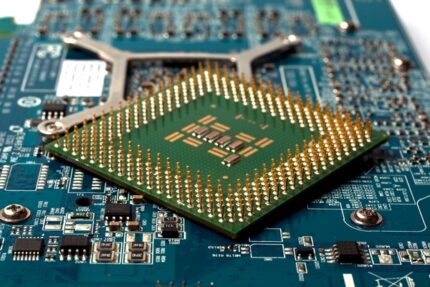There is no doubt that semiconductor stocks have underperformed the overall stock market. Since early October, the S&P 500 Index ETF (SPY) has outpaced the Semiconductor Index ETF (SOXX) by 26%.
A big reason for this was because several large consumer-facing companies found themselves with too much inventory. Companies that make electronic consumer goods, such as PCs, smart TVs, smartphones, and game consoles stockpiled chips when supply-chain problems left them unsure they could meet demand for their products during the pandemic lockdowns.
But when the economy reopened in earnest earlier this year, the demand for electronic products collapsed as people returned to the office and shifted spending to services and travel. This, in turn, forced semiconductor manufacturers like Intel (INTC) to cut production.
However, the inventory problems dogging many in the chip industry should clear in the coming months. And while it may be early, it’s still a good time to look for opportunities in semiconductor stocks…

A good example of this is a company that was once a leader in the industry, dragged down by poor management and now once again trying to become a chip powerhouse. That company is the aforementioned Intel.
Intel’s Transformation
Since returning to Intel as CEO in early 2021, Pat Gelsinger—who had previously been at Intel from 1979 to 2009—has been focused on a mission: to transform the biggest semiconductor company in the U.S. into a major contract chipmaker that will rival Samsung and Taiwan Semiconductor (TSM). And if Gelsinger manages to pull it off, Intel’s transformation will completely reshape the global semiconductor industry.
Keep in mind that Intel built its business designing and making its own cutting-edge semiconductors, mainly for PCs and servers. Manufacturing chips for external customers—known as the foundry business–is new territory for Intel. Asian rivals, like Samsung and Taiwan Semiconductor, have dominated the global foundry market for many decades.
Gelsinger’s strategy is certainly an expensive one. Since he announced the company’s pivot in March 2021, Intel has planned spending of more than $70 billion for building and expanding its chip fabrication facilities, or fabs. The company’s spending plans include:
- $20 billion for a chip facility in Ohio
- Nearly $17 billion to build a plant in Germany
- $3.5 billion to expand its chip packaging facility in New Mexico
- A $20 billion investment in Arizona fabs
- A nearly $17 billion expansion in Ireland.
On top of all that, Intel acquired the Israeli foundry firm Tower Semiconductor for $5.4 billion in February.
Intel hopes its massive bet will pay off. The company expects the foundry business will not only become a major new revenue source, but also a way to regain the technological edge in chip manufacturing lost to Asia over the past few decades.
Can Intel Pull It Off?
Wall Street hates Intel’s strategy. Its share price has more than halved since it embarked on its transformation, because Wall Street focuses on the short-term.
However, Intel does still hold the lion’s share of the PC and server processor markets.
Of course, the current slowing global demand for chips has hit Intel. The company reported a 20% year-over-year drop in its third-quarter revenue, and lowered its 2022 full-year revenue outlook to between $63 billion and $64 billion, down as much as $4 billion from its previous guidance.
Coupled with the heavy spending on its new foundry business, the company is now expecting to end 2022 with a negative $2 billion to $4 billion free cash flow, compared to the negative $1 billion to $2 billion it projected earlier this year.
I believe Gelsinger’s plan is sound. However, for it to work, Intel will need to win over customers from Taiwan Semiconductor and Samsung.
Intel has previously said that Qualcomm, Amazon’s AWS, and MediaTek have all signed up to use its manufacturing services. But it did not announce any new customers for the July–September quarter.
The key question is whether Intel can catch up in chip manufacturing technology. TSM and Samsung both began production of industry-leading 3-nanometer chips this year and aim to put 2-nanometer chips into production by 2025.
Meanwhile, Intel has still not been able to mass produce 5-nanometer chips, which are widely used in electronic products like smartphones.
But the company does say that it will begin manufacturing Intel 3 chips—its answer to TSM’s 3-nm tech—in the second half of 2023. Intel 18A production, intended to compete with TSM’s 2-nm chips, is slated to start in the second half of the following year.
Intel needs a lot more than just technology advancements. It has to build up a third-party intellectual property portfolio, design services to meet specific customer needs, and create a chip packaging and testing ecosystem with partners. All of these steps will then make it easier for customers to use Intel’s chip manufacturing process.
Keep in mind, too, that Intel has made a string of very savvy acquisitions to build its AI and automotive product offerings, including Altera, Habana Labs, Movidius, and Mobileye (MBLY), which IPO’d on October 26.
Can Intel make a successful transformation? I believe it can, with the aid of the U.S. government, which is in the midst of its geopolitical/technology battle with China.
I rate Intel as a speculative buy. Its balance sheet is still sound. At the end of 2021, it held about $38.1 billion in total debt and $28.4 billion in cash, cash equivalents, and short-term investments. The company still has ample resources for now to meet its debt obligations, capital expenditure requirements, potential acquisitions, and shareholder returns.
In the meantime, you can collect a nice quarterly dividend from INTC—shares currently yield 5.13%. Intel has paid out quarterly dividends ranging from $0.02 to $0.37 per share since December 1, 1992, and over the past five years, Intel’s dividend yield has averaged 2.4% per year, making the current yield quite attractive.
The stock is a buy in the mid- to upper 20s.





